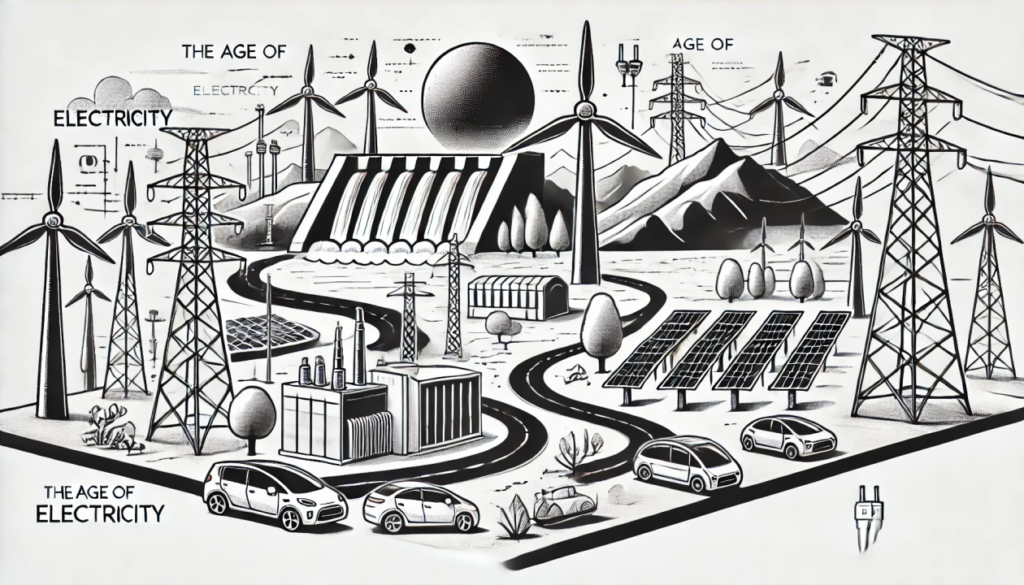
The world stands at the threshold of an electrified revolution. The Age of Electricity has arrived, promising to redefine industries, economies, and everyday life. By examining the evolution of electricity demand in the West and China, with a special focus on Canada and Québec, we uncover the key challenges and transformative opportunities that lie ahead.
The Dynamics of Electricity Demand: West vs. China
In the West, electricity demand grew steadily at an annual rate of approximately 2% from 1990 to the mid-2000s. However, this growth plateaued for nearly two decades, influenced by increased energy efficiency measures and the effects of deindustrialization. Today, we are witnessing a resurgence. Forecasts suggest that electricity consumption could increase by a factor of two, three, or even more by 2050, representing an annual growth rate of 2% to 5%.
China, on the other hand, tells a very different story. Starting from a lower baseline, the country’s electricity demand surged during the early 2000s, with annual growth rates reaching an impressive 11%. Although this rapid expansion has since moderated to around 5 or 6% per year, China remains a leader in electrification. This divergence highlights the West’s emphasis on energy efficiency and China’s accelerated industrialization trajectory.
The Rise of Electrification
Globally, the share of electricity in final energy consumption has increased significantly, rising from approximately 14% to 20% over the years. Québec presents an even more striking example of progress. With its abundant hydroelectric resources and Hydro Québec’s pioneering efforts, electricity now constitutes nearly half of the province’s energy consumption. In contrast, the West has generally stagnated at around 20%, while China has surged ahead, now achieving a 30% share.
These figures highlight an urgent reality: the West lags behind in the global electrification transition. As we advance further into this electrified era, addressing this disparity is crucial for future growth and sustainability. From a geopolitical perspective, this also puts China in a leading position for the developing world.
Why Electricity Is the Future
The era of electricity isn’t merely an option; rather, it’s an unavoidable reality. Decades of advancements in energy efficiency have positioned electricity as an increasingly competitive alternative to fossil fuels. Heat pumps, for example, can generate up to 3 kWh of heat for every 1 kWh of electricity consumed. Even when electricity is derived from a combined-cycle gas turbine, the total energy usage is lower compared to heating directly with natural gas. Similar efficiencies are evident in electric vehicles and induction stoves. Additionally, air conditioning—a growing necessity in many parts of the world—relies exclusively on electricity, as does much of the light industry, which continues to shift towards electric power.
As demand accelerates, the electricity sector is poised for transformative growth. Renewable energy sources like wind and solar, complemented by battery storage systems, are driving significant innovation while often being the most cost-effective options for new energy generation. Solar panels and batteries, increasingly installed at customer sites, also boost decentralized energy access. Despite the transition, traditional fossil fuel and nuclear plants will remain crucial in ensuring a stable energy supply.
Lessons From China and Challenges for the West
China’s strategic foresight in building a robust electricity supply chain over the past two decades offers a valuable roadmap for the West. The country has established itself as a leader not only in manufacturing solar panels, wind turbines, and batteries but also in producing critical components, such as transformers, switches, and advanced systems for direct current (DC) transmission lines. While Canada’s Hydro-Québec was a trailblazer in pioneering 735 kV alternating current (AC) transmission lines in the 20th century, China has surpassed this achievement with its 1,100 kV DC transmission lines, demonstrating superior technological advancements.
For the West, transitioning abruptly from decades of stagnant electricity demand to a phase of rapid growth presents unique challenges. Years of underinvestment, combined with stringent regulatory frameworks, have left utilities and infrastructure owners struggling to scale up. Rebuilding domestic manufacturing capacity, streamlining permitting processes, and fostering innovation will be pivotal to advancing the next phase of growth.
Building for the Future
To thrive in the Age of Electricity, bold, forward-thinking policies and industrial strategies are imperative. Governments must prioritize investments in grid modernization, renewable energy, and the development of domestic manufacturing capabilities. Utilities, in turn, should adopt innovative solutions to accelerate the deployment of critical infrastructure. Regulatory frameworks must strike a careful balance between safeguarding environmental standards and addressing the urgent need to expand capacity.
Canada, and Québec in particular, are uniquely positioned to lead this transition. By capitalizing on their hydroelectric expertise and committing to investments in emerging technologies, they can establish a global benchmark for sustainable and efficient energy systems. In particular, Quebec’s electricity supply chain is relatively large because it must support a significant portion of the final energy consumption in the province.
Conclusion
The Age of Electricity is not a distant aspiration; it is unfolding in real time. As electricity demand continues to surge, driven by decarbonization efforts and technological innovation, the West must take decisive action to bridge the gap. By drawing lessons from China’s proactive approach and leveraging local strengths, we can overcome the challenges ahead and unlock the immense potential of a fully electrified future.